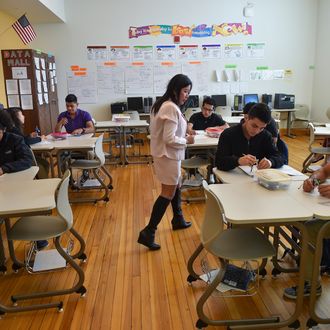
America recently celebrated the highest graduation rate in its recorded history, with 82 percent of high-school seniors completing their diplomas in 2014. But on Wednesday, the Department of Education called the significance of that milestone into question: According to the 2015 National Assessment of Educational Progress (NAEP), only 37 percent of U.S. seniors showed “college or career ready” proficiency in math and reading.
The NAEP is the North Star for bureaucrats looking to measure America’s academic performance. Unlike state accountability tests, the content of the NAEP remains constant over time, offering a steady barometer of achievement. What’s more, since teachers suffer no consequences if their students perform poorly on the NAEP, no one drills past tests into their students’ brains until they become question-bubbling automata. Thus, the test is a relatively reliable measure of educational attainment rather than test-prepping skills.
The 2015 results show that high-school seniors were less proficient in math than they were in 2013, while their reading skills remained unchanged. Although the drop in the students’ average math score was relatively small, that average fails to capture the story told by the broader results. Which, like so many others in modern America, is a story of inequality.
The highest-performing seniors in American schools — those whose scores put them in the 90th percentile nationwide — actually saw an improvement in their reading scores, while their math scores went unchanged. But students who scored in the 10th and 25th percentiles saw declines in both reading and math.
As the Washington Post notes, the students on the losing end of this growing achievement gap are disproportionately African-American and Hispanic. While 47 percent of Asian students and 32 percent of white students scored proficient or above in math, only 12 percent of Hispanic students and 7 percent of black students did the same.
The disproportionate rate of poverty among African-American and Hispanic children in the United States likely accounts for much of this discrepancy. In 2015, Pew Research found that nearly 40 percent of black children lived in poverty, compared to a national average of 20 percent. Institutional racism exacerbates this material disadvantage, as studies consistently show teachers more readily suspend black students than their white peers. According to a 2014 report by the Department of Education, while black students represent 18 percent of preschool enrollment, they account for 42 percent of preschoolers who are suspended once, and 48 percent of those who are suspended multiple times.
If such high rates of early childhood poverty and suspension persist, it’s hard to imagine that more standardized testing and teacher evaluating will bring America report cards fine enough to post on the fridge.






























